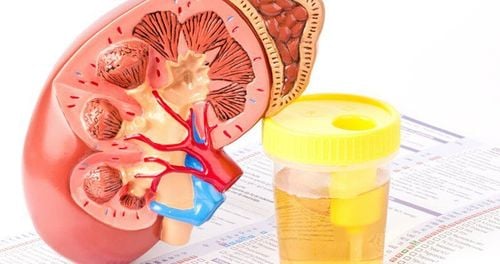This is an automatically translated article.
The article was professionally consulted with Specialist Doctor II Lai Thi Nguyet Hang - Obstetrician and Gynecologist - Department of Obstetrics and Gynecology - Vinmec Ha Long International General Hospital.Assessing the amount of protein in the urine of a pregnant woman is an important test during pregnancy to monitor the health of the kidneys and the whole body. The finding of proteinuria may allow for a ready diagnosis and intervention for complications of preeclampsia and glomerulonephritis, which can affect labor. Furthermore, proteinuria in pregnancy alone is also a risk factor. Therefore, determining the quantitative index of protein in the urine of pregnant women is essential.
1. What is proteinuria in pregnancy?
Proteinuria is a marker of kidney damage and identifies people at risk of worsening kidney disease. Urinary protein excretion increases during normal pregnancy from less than 150 mg/day in nonpregnant women to 300 mg/day in pregnant women. Therefore, the threshold for abnormal protein secretion for the diagnosis of preeclampsia is above 300 mg/24 h or more than 2+ by urine dipstick test.Accordingly, the definition of proteinuria in pregnancy is when there is a new appearance of protein in the urine in amounts equal to or greater than 300 mg of protein during a 24-hour collection, with a protein/creatinine ratio equal or greater more than 0.3 mg/mg, or +2 or more on a dipstick test.
2. Quantitative indicators of protein in the urine of pregnant women
Several tests are currently being used to detect proteinuria not only in pregnant women but also in normal people. These tests can vary in sensitivity, specificity, time, cost, and simplicity to perform.
3. Quantification of Acetic Acid/Sulfosalicylic Acid
In some laboratories, quantification of proteinuria through the urine acetic acid/sulfosalicylic acid assay is commonly used to screen for proteinuria in pregnancy.This method is very simple, by adding a few drops of diluted acetic acid to 5ml of urine in a test tube, then heating the urine to below boiling point. Depending on the turbidity of the specimen, the presence of protein in the urine is semi-quantitative from 1+ to 4+.
This test has the advantage of being less expensive and can detect different proteins in the urine at the same time.
4. Urine dipstick
The urine dipstick is also a semi-quantitative test for proteinuria and can be performed at the routine antenatal clinic.However, besides convenience, a limitation of urine dipsticks is that the accuracy in predicting proteinuria is poor at threshold 1+, with positive and negative predictive values for proteinuria. significant deviation. Accordingly, the accuracy of the dipstick test should be trusted at a higher threshold (i.e. greater than 1+ proteinuria).
5. Quantification of proteinuria in 24 hours
The gold standard for quantification of proteinuria is the need for a 24-hour urine protein collection.In addition to quantifying the total amount of protein excreted in the urine over the course of a day, this method also allows the calculation of creatinine clearance as an estimate of glomerular filtration.
However, 24-hour urine collection is generally inconvenient for the patient and often inaccurate due to the need to collect so many times. Therefore, when interpreting 24-hour urine collection results, it is important to assess the adequacy of specimen collection; At the same time, the amount of creatinine excreted in the 24-hour urine should be 15-20 mg of creatinine/kg body weight with the weight of the woman before pregnancy.

6. Protein/creatinine ratio in urine
The local urinary protein/creatinine ratio is a relatively reliable, accurate, and easy method for the quantification of proteinuria. As a result, this test has largely replaced 24-hour urine collection.There is ample evidence that the urine protein/creatinine ratio is accurate for quantifying proteinuria in pregnancy. This test has become the preferred method for the quantification of proteinuria due to its accuracy, reproducibility and avoidance of the need for a 24-hour urine collection.
7. Albumin/creatinine ratio in urine
Another test that can substitute for the urine protein/creatinine ratio is the urine albumin/creatinine ratio.This indicator can also be measured with an automated analyzer, available as a quick in-clinic test.
8. Classification of proteinuria in pregnancy
Proteinuria in pregnancy can be classified into the following 4 main groups:8.1 Proteinuria Isolated Proteinuria Isolated proteinuria is defined as the presence of newly detected proteinuria with a concentration above 300 mg/g Cr at any time during pregnancy without hypertension, UTIs, comorbidities, or any other obvious cause.
Gestational proteinuria is part of isolated proteinuria, defined as proteinuria that develops after 20 weeks of gestation in the absence of hypertension. Because gestational proteinuria often progresses to preeclampsia, this is a retrospective diagnosis that can only be confirmed after delivery if preeclampsia is not acquired.
So far it is not clear what causes proteinuria alone in the absence of hypertension. Some hypothesize that it is due to maternal factors interacting with placental growth factors. During follow-up, proteinuria alone often progresses to preeclampsia. However, eclampsia can occasionally occur in patients with isolated proteinuria without associated hypertension.
8.2 Proteinuria associated with preeclampsia Hypertension in pregnancy is defined as blood pressure greater than 140 mmHg systolic or greater than 90 mmHg diastolic. Among pregnant women experiencing hypertension in pregnancy, proteinuria was common in all subjects, except gestational hypertension. In parallel, the criteria for the diagnosis of preeclampsia include elevated blood pressure and proteinuria or, in the absence of proteinuria, high blood pressure plus some other serious features: renal failure, low platelets , impaired liver function, pulmonary edema, or cerebral or visual symptoms.

When proteinuria is noted early in pregnancy, i.e. before 20 weeks, the condition is confirmed as chronic proteinuria and is usually due to underlying kidney disease. In contrast, when proteinuria is first noted late, after 20 weeks, it is usually due to gestational proteinuria or preeclampsia.
8.4 Proteinuria as a complication of UTIs in pregnancy Urinary tract infections are a very common problem during pregnancy. The cause is the urinary tract is congested due to increased intra-abdominal pressure and also dilated, structural changes due to pregnancy hormones.
Urinary tract infections can cause transient proteinuria and should be ruled out before attributing proteinuria in pregnancy to another cause, such as chronic kidney disease or preeclampsia.
In summary, because of the dangers posed by preeclampsia, confirmation and quantification of protein in pregnant women's urine is essential, as a routine test during antenatal visits. However, since there are other causes of proteinuria in pregnancy, such as underlying kidney problems or UTIs, the outcome should be interpreted with caution and the mother should be approached for treatment. Appropriate follow-up thereafter, ensures a safe pregnancy.
To protect the health of pregnant women and their babies during pregnancy, Vinmec International General Hospital provides a package of maternity services as a solution to help pregnant women feel secure because of the companionship of the medical team. doctor throughout pregnancy. When choosing Maternity Package, pregnant women can:
The pregnancy process is monitored by a team of highly qualified doctors Regular check-ups, early detection of abnormalities The package pregnancy helps to facilitate Convenience for the birthing process Newborns receive comprehensive care For consultation and examination at Vinmec medical system nationwide, please register at the Website for the best service.
Please dial HOTLINE for more information or register for an appointment HERE. Download MyVinmec app to make appointments faster and to manage your bookings easily.














